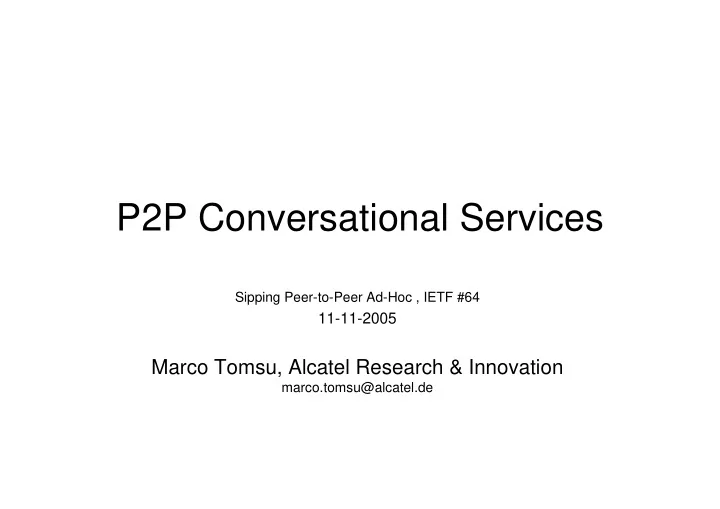

P2P Conversational Services Sipping Peer-to-Peer Ad-Hoc , IETF #64 11-11-2005 Marco Tomsu, Alcatel Research & Innovation marco.tomsu@alcatel.de
Outline • P2P Services Dilemma • Conversational Services Digest • P2P SIP Basic Service Requirements 2
P2P Services Dilemma • Public network operators should not look at P2P as a threat only … – OK, free E2E services with only little operator lock-in seems bad – End device based dynamic innovation is a difficult business environment – How to impose regulatory and service integrity issues in case of lost admin control • … but take also the chances of a new technology: – Self-organization of distributed cheap resources may bring better scalability, robustness and lower cost – Overlays above IP allow for new concepts e.g. for cross technology mobility, redundancy, … – New valuable services beyond call control – Richer end-user communication 3
Conversational Services Digest • Not apps, but services ;-) • Not classified into centralized – decentralized • Domain and user authority • Basic and supplementary call services • Directory (searchable) beyond DHT • Buddy list / presence • NAT traversal or trans-coding relays • Interconnection of domains • GW to legacy services/networks (FAX, PSTN, SMS/MMS, PLMN, …) • Service peers handling preferences, mail box, conferencing, SPIT filter • E2E Encryption • Emergency call handling (with location information) • Intelligence support (invisible to users, for public service only) • Interfaces to transport network: QoS, location, … • And what’s the relation to a P2P SIP protocol ? 4
Open P2P Communication System • In contrast to closed proprietary systems around, an open standardized proposal requires at least: – Trusted strong identities – Sophisticated security means against system abuse – Concept for administrative domains – Variable architecture concepts for different use cases – Standardized well known selected services definition – Open extendibility, leaving room for evolution – Anticipation of regulatory issues 5
P2P SIP Basic Requirements • 1. Handling of heterogeneity – Centralized – decentralized services – Different device capabilities • Processing power • Storage • Access link • Availability ������� ������� ������� ������� ����������� ����������� ����������� ����������� ���� ���� ����������� ����������� ����������� ����������� ���� ���� �������������� �������������� �������������� �������������� • Load • Service description • User preferences �� �� �� �� • Policies and roles ����� ����� ����� ����� ������� ������� ������� ������� 6
Backup: Handling of heterogeneity • Problem: – asymmetric / unbalanced behavior – creates hot zones in the P2P network � high load at the requested peer and • at some nodes forwarding queries • Careful design of P2P protocol ������������������������� ������������������ to avoid hotspots nearby ������������������� massively loaded service peers – careful service peer positioning in the P2P structure – load balancing or caching mechanisms 7
P2P SIP Basic Requirements • 2. P2P trust – beyond identity management: Secured data base operations – Controlled access to DB entries and integrity of DB content • Particularly third party access (read, write, create, change, …) • Security against misbehaving DHT nodes • Size of DB storage ������ ������ ������ ������ ������ ������ ������ ������ ������������������ ������������������ ������������������ ������������������ ������������������ ������������������ ������������������ ������������������ %&�"�'������ ( )!* %&�"�'������ ������ ������ ������ ������ ������ ������ ������ ������ ( )!* �&�+������ ( )!* ,&�-��������+����������� ��� ����"�������������� �����! �����! �����! �����! �����! �����! �����! �����! "������������������ #� "�������������� ���� #�$ $ "������������������ #� "������������������ #� "������������������ #� "������������������ #�$ $ $ $ "�������������� "�������������� ���� #� ���� #� $ $ 8
P2P SIP Basic Requirements • 3. Domains – By administration – By topology – By geography – By resources or roles – By contract – By common interest • Finally: Regulatory issues – Anticipate killer requirement for any public conversational service – Support of emergency calls and ways to deliver location information – Support of CALEA / LI (at least: CDR) 9
Proposals • Revise requirements draft where required • DHT access rights and data size • Heterogeneity • Domain concept • Regulatory issues • Narrow scope – Focused on simple basic system – Offering basic services • Analyze re-use of sip/sipping work on services • Thanks! Questions? 10
Recommend
More recommend